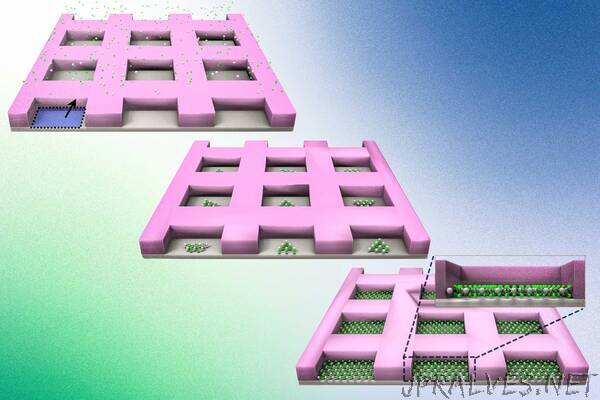
“Their technique could allow chip manufacturers to produce next-generation transistors based on materials other than silicon.
True to Moore’s Law, the number of transistors on a microchip has doubled every year since the 1960s. But this trajectory is predicted to soon plateau because silicon — the backbone of modern transistors — loses its electrical properties once devices made from this material dip below a certain size.
Enter 2D materials — delicate, two-dimensional sheets of perfect crystals that are as thin as a single atom. At the scale of nanometers, 2D materials can conduct electrons far more efficiently than silicon. The search for next-generation transistor materials therefore has focused on 2D materials as potential successors to silicon.
But before the electronics industry can transition to 2D materials, scientists have to first find a way to engineer the materials on industry-standard silicon wafers while preserving their perfect crystalline form. And MIT engineers may now have a solution.
The team has developed a method that could enable chip manufacturers to fabricate ever-smaller transistors from 2D materials by growing them on existing wafers of silicon and other materials. The new method is a form of “nonepitaxial, single-crystalline growth,” which the team used for the first time to grow pure, defect-free 2D materials onto industrial silicon wafers.
With their method, the team fabricated a simple functional transistor from a type of 2D materials called transition-metal dichalcogenides, or TMDs, which are known to conduct electricity better than silicon at nanometer scales.
“We expect our technology could enable the development of 2D semiconductor-based, high-performance, next-generation electronic devices,” says Jeehwan Kim, associate professor of mechanical engineering at MIT. “We’ve unlocked a way to catch up to Moore’s Law using 2D materials.”
Kim and his colleagues detail their method in a paper appearing today in Nature. The study’s MIT co-authors include Ki Seok Kim, Doyoon Lee, Celesta Chang, Seunghwan Seo, Hyunseok Kim, Jiho Shin, Sangho Lee, Jun Min Suh, and Bo-In Park, along with collaborators at the University of Texas at Dallas, the University of California at Riverside, Washington University in Saint Louis, and institutions across South Korea.
A crystal patchwork
To produce a 2D material, researchers have typically employed a manual process by which an atom-thin flake is carefully exfoliated from a bulk material, like peeling away the layers of an onion.
But most bulk materials are polycrystalline, containing multiple crystals that grow in random orientations. Where one crystal meets another, the “grain boundary” acts as an electric barrier. Any electrons flowing through one crystal suddenly stop when met with a crystal of a different orientation, damping a material’s conductivity. Even after exfoliating a 2D flake, researchers must then search the flake for “single-crystalline” regions — a tedious and time-intensive process that is difficult to apply at industrial scales.
Recently, researchers have found other ways to fabricate 2D materials, by growing them on wafers of sapphire — a material with a hexagonal pattern of atoms which encourages 2D materials to assemble in the same, single-crystalline orientation.
“But nobody uses sapphire in the memory or logic industry,” Kim says. “All the infrastructure is based on silicon. For semiconductor processing, you need to use silicon wafers.”
However, wafers of silicon lack sapphire’s hexagonal supporting scaffold. When researchers attempt to grow 2D materials on silicon, the result is a random patchwork of crystals that merge haphazardly, forming numerous grain boundaries that stymie conductivity.
“It’s considered almost impossible to grow single-crystalline 2D materials on silicon,” Kim says. “Now we show you can. And our trick is to prevent the formation of grain boundaries.”
Seed pockets
The team’s new “nonepitaxial, single-crystalline growth” does not require peeling and searching flakes of 2D material. Instead, the researchers use conventional vapor deposition methods to pump atoms across a silicon wafer. The atoms eventually settle on the wafer and nucleate, growing into two-dimensional crystal orientations. If left alone, each “nucleus,” or seed of a crystal, would grow in random orientations across the silicon wafer. But Kim and his colleagues found a way to align each growing crystal to create single-crystalline regions across the entire wafer.
To do so, they first covered a silicon wafer in a “mask” — a coating of silicon dioxide that they patterned into tiny pockets, each designed to trap a crystal seed. Across the masked wafer, they then flowed a gas of atoms that settled into each pocket to form a 2D material — in this case, a TMD. The mask’s pockets corralled the atoms and encouraged them to assemble on the silicon wafer in the same, single-crystalline orientation.
“That is a very shocking result,” Kim says “You have single-crystalline growth everywhere, even if there is no epitaxial relation between the 2D material and silicon wafer.”
With their masking method, the team fabricated a simple TMD transistor and showed that its electrical performance was just as good as a pure flake of the same material.
They also applied the method to engineer a multilayered device. After covering a silicon wafer with a patterned mask, they grew one type of 2D material to fill half of each square, then grew a second type of 2D material over the first layer to fill the rest of the squares. The result was an ultrathin, single-crystalline bilayer structure within each square. Kim says that going forward, multiple 2D materials could be grown and stacked together in this way to make ultrathin, flexible, and multifunctional films.
“Until now, there has been no way of making 2D materials in single-crystalline form on silicon wafers, thus the whole community has been struggling to realize next-generation processors without transferring 2D materials,” Kim says. “Now we have completely solved this problem, with a way to make devices smaller than a few nanometers. This will change the paradigm of Moore’s Law.”
This research was supported in part by the U.S. Defense Advanced Research Projects Agency, Intel, the IARPA MicroE4AI program, MicroLink Devices, Inc., ROHM Co., and Samsung.”
